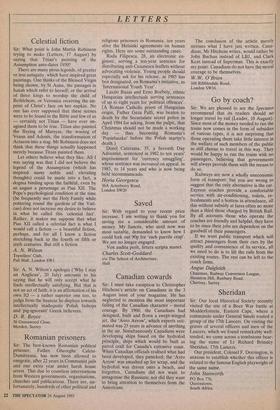LETTERS Celestial fiction
Sir: What point is John Martin Robinson trying to make (Letters, 17 August) by saying that Titian's painting of the Assumption ante-dates 1950?
There are many pious legends, of greater or less antiquity, which have inspired great paintings. One thinks of the Blessed Virgin being shown, by St Anna, the passages in Isaiah which refer to herself; or the arrival of three kings to worship the child of Bethlehem; or Veronica receiving the im- print of Christ's face on her napkin. No one has ever supposed that these scenes were to be found in the Bible and few of us — certainly not Titian — have ever im- agined them to be true. Titian also painted the flaying of Marsyas, the wooing of 'Venus and Adonis, the transformation of Actaeon into a stag. Mr Robinson does not think that these things actually happened merely because Titain painted them.
Let others believe what they like. All I was saying was that I did not believe the legend of the Assumption (which has inspired many noble and elevating thoughts) could be made into a fact, a dogma binding upon the faithful, even by so august a personage as Pius XII. The Pope's psychological condition at the time (he frequently met the Holy Family while pottering round the gardens of the Vati- can) does not increase my desire to believe in what he called this 'celestial fact'. Rather, it makes me suppose that what Pius XII called a celestial fact is what I would call a fiction — a beautiful fiction, perhaps, and for all I know a fiction stretching back to the fourth or fifth or sixth centuries. But still a fiction.
A. N. Wilson
Travellers' Club, Pall Mall, London SWI










































 Previous page
Previous page